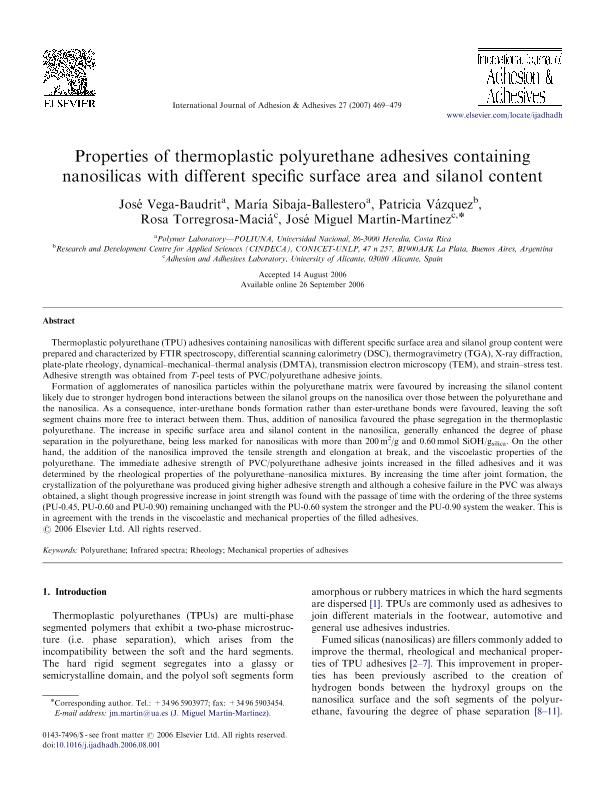Mostrar el registro sencillo del ítem
dc.contributor.author
Vega Baudrit, José

dc.contributor.author
Sibaja Ballester, María

dc.contributor.author
Vazquez, Patricia Graciela

dc.contributor.author
Torregrosa Maciá, Rosa

dc.contributor.author
Martín Martínez, José Miguel

dc.date.available
2017-05-19T18:19:55Z
dc.date.issued
2007-09
dc.identifier.citation
Vega Baudrit, José; Sibaja Ballester, María; Vazquez, Patricia Graciela; Torregrosa Maciá, Rosa; Martín Martínez, José Miguel; Properties of thermoplastic polyurethane adhesives containing nanosilicas with different specific surface area and silanol content; Elsevier; International Journal Of Adhesion And Adhesives; 27; 6; 9-2007; 469-476
dc.identifier.issn
0143-7496
dc.identifier.uri
http://hdl.handle.net/11336/16751
dc.description.abstract
Thermoplastic polyurethane (TPU) adhesives containing nanosilicas with different specific surface area and silanol group content were prepared and characterized by FTIR spectroscopy, differential scanning calorimetry (DSC), thermogravimetry (TGA), X-ray diffraction, plate-plate rheology, dynamical–mechanical–thermal analysis (DMTA), transmission electron microscopy (TEM), and strain–stress test.
Adhesive strength was obtained from T-peel tests of PVC/polyurethane adhesive joints. Formation of agglomerates of nanosilica particles within the polyurethane matrix were favoured by increasing the silanol content likely due to stronger hydrogen bond interactions between the silanol groups on the nanosilica over those between the polyurethane and the nanosilica. As a consequence, inter-urethane bonds formation rather than ester-urethane bonds were favoured, leaving the soft segment chains more free to interact between them. Thus, addition of nanosilica favoured the phase segregation in the thermoplastic polyurethane. The increase in specific surface area and silanol content in the nanosilica, generally enhanced the degree of phase separation in the polyurethane, being less marked for nanosilicas with more than 200 m2/g and 0.60 mmol SiOH/gsilica. On the other
hand, the addition of the nanosilica improved the tensile strength and elongation at break, and the viscoelastic properties of the polyurethane. The immediate adhesive strength of PVC/polyurethane adhesive joints increased in the filled adhesives and it was determined by the rheological properties of the polyurethane–nanosilica mixtures. By increasing the time after joint formation, the crystallization of the polyurethane was produced giving higher adhesive strength and although a cohesive failure in the PVC was always obtained, a slight though progressive increase in joint strength was found with the passage of time with the ordering of the three systems (PU-0.45, PU-0.60 and PU-0.90) remaining unchanged with the PU-0.60 system the stronger and the PU-0.90 system the weaker. This is in agreement with the trends in the viscoelastic and mechanical properties of the filled adhesives.
dc.format
application/pdf
dc.language.iso
eng
dc.publisher
Elsevier

dc.rights
info:eu-repo/semantics/openAccess
dc.rights.uri
https://creativecommons.org/licenses/by-nc-nd/2.5/ar/
dc.subject
Polyurethane
dc.subject
Infrared Spectra
dc.subject
Rheology
dc.subject
Mechanical Properties of Adhesives
dc.subject.classification
Ingeniería Química

dc.subject.classification
Ingeniería Química

dc.subject.classification
INGENIERÍAS Y TECNOLOGÍAS

dc.title
Properties of thermoplastic polyurethane adhesives containing nanosilicas with different specific surface area and silanol content
dc.type
info:eu-repo/semantics/article
dc.type
info:ar-repo/semantics/artículo
dc.type
info:eu-repo/semantics/publishedVersion
dc.date.updated
2017-05-17T13:50:16Z
dc.journal.volume
27
dc.journal.number
6
dc.journal.pagination
469-476
dc.journal.pais
Países Bajos

dc.journal.ciudad
Amsterdam
dc.description.fil
Fil: Vega Baudrit, José. Universidad Nacional. Facultad de ciencias exactas y naturales. Laboratorio de polimeros; Costa Rica
dc.description.fil
Fil: Sibaja Ballester, María. Universidad Nacional. Facultad de ciencias exactas y naturales. Laboratorio de polimeros; Costa Rica
dc.description.fil
Fil: Vazquez, Patricia Graciela. Consejo Nacional de Investigaciones Científicas y Técnicas. Centro Científico Tecnológico Conicet - La Plata. Centro de Investigación y Desarrollo En Ciencias Aplicadas "Dr. Jorge J. Ronco". Universidad Nacional de la Plata. Facultad de Ciencias Exactas. Centro de Investigación y Desarrollo en Ciencias Aplicadas; Argentina
dc.description.fil
Fil: Torregrosa-Macia, Rosa. Universidad de Alicante. Departamento de química inorgánica. Laboratorio de adhesión y adhesivos; España
dc.description.fil
Fil: Martın-Martınez, Jose Miguel. Universidad de Alicante. Departamento de química inorgánica. Laboratorio de adhesión y adhesivos; España
dc.journal.title
International Journal Of Adhesion And Adhesives

dc.relation.alternativeid
info:eu-repo/semantics/altIdentifier/url/http://www.sciencedirect.com/science/article/pii/S0143749606000819
dc.relation.alternativeid
info:eu-repo/semantics/altIdentifier/doi/http://dx.doi.org/doi:10.1016/j.ijadhadh.2006.08.001
Archivos asociados
